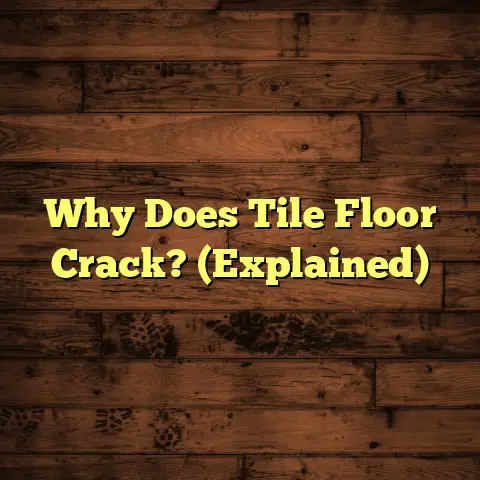Basement Water Seepage? (1 Call Saves Floors!)
Imagine a future where basement water seepage is a problem of the past. Sounds good, right?
I’m talking about homes where advancements in technology, construction materials, and water management systems have created healthier, drier living spaces.
Think about never having to worry about that musty smell or the fear of finding a puddle after a heavy rain.
We’re moving towards a future where proactive measures and modern solutions prevent water seepage before it even starts.
That’s the future I want to help you build.
It’s about preserving the integrity of your home and giving you peace of mind.
Being ahead of the curve when it comes to basement waterproofing and maintenance is key.
It’s not just about fixing problems; it’s about preventing them in the first place.
I’ve seen firsthand how devastating water damage can be.
But I’ve also seen how effective modern solutions can be when applied correctly.
Let’s dive into how you can protect your home and your family.
Section 1: Understanding Basement Water Seepage
So, what is basement water seepage, exactly?
Simply put, it’s the unwanted intrusion of water into your basement.
This can happen through walls, floors, or even the joints where they meet.
There are several culprits behind this:
- Poor Drainage: If rainwater isn’t directed away from your foundation, it can pool and seep in.
- Heavy Rainfall: Intense storms can overwhelm drainage systems, leading to water buildup around your home.
- Plumbing Leaks: Hidden leaks in your pipes can saturate the surrounding soil and eventually seep into your basement.
- Groundwater Pressure: The soil around your foundation can become saturated with water, creating hydrostatic pressure that forces water through cracks and pores.
You might notice dampness, mold growth, or even visible water.
Sometimes, the damage is more subtle, like a musty odor or efflorescence (those white, powdery deposits on your walls).
Why are basements so susceptible?
It all comes down to physics.
Your basement is essentially a below-grade structure surrounded by soil.
That soil is often saturated with water, creating hydrostatic pressure.
This pressure constantly pushes water against your foundation walls and floor.
Concrete, while strong, is also porous.
Over time, water can penetrate these pores, especially if there are cracks or weaknesses.
Think of it like a sponge constantly being squeezed – eventually, water will come out.
Section 2: The Consequences of Ignoring Water Seepage
Ignoring water seepage is like ignoring a toothache – it only gets worse.
The short-term effects can be unpleasant.
Think of that musty smell, dampness, and the potential for mold and mildew growth.
Mold isn’t just unsightly; it can also pose serious health risks.
According to the EPA, mold exposure can cause:
- Respiratory problems
- Allergic reactions
- Asthma attacks
And that’s just the beginning.
In the long term, water seepage can cause significant structural damage.
It can weaken your foundation, leading to cracks, settling, and even collapse.
This can be incredibly expensive to repair.
I’ve seen homeowners face tens of thousands of dollars in repair costs because they ignored early signs of water damage.
Case Study:
I once worked with a family who dismissed a small leak in their basement as “just a little dampness.”
Over time, the leak worsened, leading to extensive mold growth and structural damage.
They ended up having to gut their entire basement, costing them over $50,000.
The emotional toll was significant as well.
They felt stressed, anxious, and violated by the damage to their home.
Plus, the value of their property plummeted, making it difficult to sell.
Don’t let this happen to you!
Section 3: Identifying the Signs of Water Seepage
The key to preventing major damage is early detection.
Here’s a comprehensive checklist of signs to look for:
Visual Cues:
- Stains on Walls: Look for dark or discolored patches on your basement walls, especially near the floor.
- Efflorescence: These white, powdery deposits are a sign that water is seeping through your walls and evaporating, leaving behind mineral salts.
- Visible Mold: Mold can appear in various colors, including black, green, brown, or white. It often has a fuzzy or slimy texture.
- Cracks in Walls or Floors: Even small cracks can allow water to enter your basement.
- Puddles of Water: This is the most obvious sign of water seepage, but it may not always be present.
Other Signs:
- Musty Odors: A persistent musty smell is a telltale sign of mold and mildew growth, even if you can’t see it.
- Increased Humidity Levels: If your basement feels damp or clammy, it could be a sign of water seepage. A hygrometer can help you measure humidity levels.
- Unexplained Spikes in Energy Bills: Moisture in your basement can make your HVAC system work harder to maintain a comfortable temperature, leading to higher energy bills.
- Rusting Appliances: If you have appliances in your basement, such as a water heater or washing machine, check for signs of rust. This can indicate excessive moisture.
- Warping or Rotting Wood: If you have wood framing or trim in your basement, check for signs of warping, rotting, or discoloration.
Don’t ignore these signs!
Even if you only notice one or two of these indicators, it’s worth investigating further.
Section 4: The Importance of Early Intervention
Why is early intervention so crucial?
Because small water seepage issues can quickly escalate into major problems.
A tiny crack in your foundation can become a gaping hole over time.
A small patch of mold can spread rapidly, contaminating your entire basement.
Addressing water seepage immediately offers several benefits:
- Cost Savings: The sooner you address the problem, the less damage it will cause, and the less it will cost to repair.
- Safety: Preventing mold growth and structural damage protects the health and safety of your family.
- Preserving Home Value: Addressing water seepage issues helps maintain the value of your home and prevents costly repairs down the road.
According to the American Society of Home Inspectors (ASHI), homes with untreated water damage can lose up to 25% of their value.
Think about it:
Would you rather spend a few hundred dollars to fix a small crack, or tens of thousands of dollars to repair a crumbling foundation?
Early detection and remediation are always the best approach.
Section 5: Solutions for Basement Water Seepage
Okay, so you’ve identified a water seepage problem.
What now?
Fortunately, there are several effective solutions available:
-
Exterior Waterproofing Systems: This involves excavating around your foundation and applying a waterproof membrane to the exterior walls. This is the most comprehensive solution, as it prevents water from ever entering your basement in the first place.
- Pros: Most effective, long-lasting.
- Cons: Most expensive, requires excavation.
-
Interior Waterproofing Systems: This involves installing a drainage system along the perimeter of your basement floor and walls. The water is then collected and pumped out using a sump pump.
-
Pros: Less expensive than exterior waterproofing, doesn’t require excavation.
- Cons: Doesn’t prevent water from entering your foundation walls, may require ongoing maintenance.
-
Drainage Solutions: Improving drainage around your home can help prevent water from pooling near your foundation. This can involve installing French drains, grading your yard to slope away from your foundation, and cleaning out gutters and downspouts.
-
Pros: Relatively inexpensive, can be done as a DIY project.
- Cons: May not be sufficient for severe water seepage problems.
-
Sump Pumps: A sump pump is a device that automatically pumps water out of your basement. It’s typically installed in a sump pit, which is a hole in your basement floor.
-
Pros: Effective for removing water that has already entered your basement, relatively inexpensive.
- Cons: Requires electricity to operate, may fail during power outages.
-
Dehumidifiers: A dehumidifier can help reduce humidity levels in your basement, which can prevent mold growth.
-
Pros: Relatively inexpensive, easy to use.
- Cons: Doesn’t address the source of the water seepage, only treats the symptoms.
Which solution is right for you?
It depends on the severity of the problem and your budget.
A professional assessment is essential to determine the best course of action.
That’s where the “1 call saves floors” part comes in.
By connecting with experts, you can get a tailored solution that addresses your specific needs.
Section 6: Choosing the Right Professionals
Choosing the right contractor is crucial for ensuring a successful waterproofing project.
Here’s what to look for:
- Certifications: Look for contractors who are certified by reputable organizations, such as the National Association of Waterproofing and Structural Repair Contractors (NAWSRC).
- Experience: Choose a contractor with a proven track record of successful waterproofing projects. Ask for references and check online reviews.
- Customer Reviews: Read online reviews on sites like Google, Yelp, and the Better Business Bureau to get a sense of the contractor’s reputation.
- Warranty Offerings: Make sure the contractor offers a warranty on their work. This will protect you in case of any problems down the road.
Don’t be afraid to get multiple quotes.
Contact at least three different contractors and get written estimates.
Compare the estimates carefully, paying attention to the scope of work, materials used, and warranty offered.
Ask each contractor to explain their proposed solution in detail and answer any questions you may have.
Trust your gut.
Choose a contractor who you feel comfortable working with and who you trust to do the job right.
Conclusion: A Call to Action for Homeowners
Basement water seepage is a serious problem that can have devastating consequences if left untreated.
But by taking proactive measures and addressing the issue early, you can protect your home and your family.
I urge you to take the first step today.
Evaluate your home for signs of water seepage.
Look for stains, efflorescence, mold, and musty odors.
Check your humidity levels and inspect your foundation for cracks.
And then, make that crucial call to a professional.
Connect with experts who can provide tailored solutions and help you protect your home from water damage.
Investing in waterproofing solutions is an investment in your future.
It’s an investment in the health and safety of your family.
And it’s an investment in the value of your home.
So, don’t wait until it’s too late.
Take action now and enjoy the peace of mind that comes with knowing your home is protected.
Remember, 1 call saves floors!





